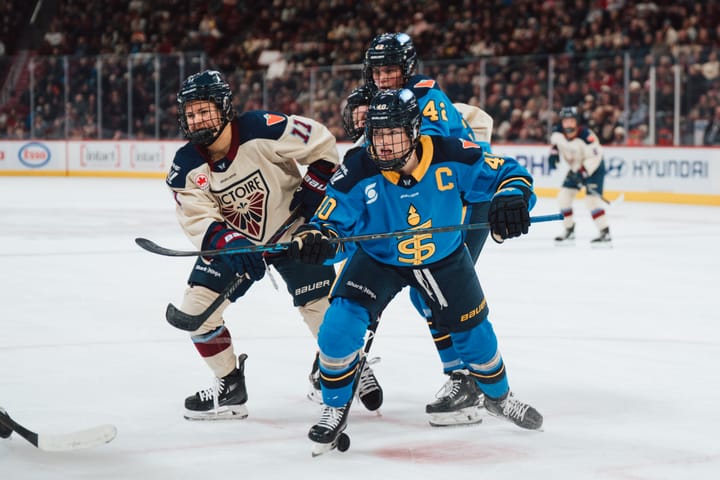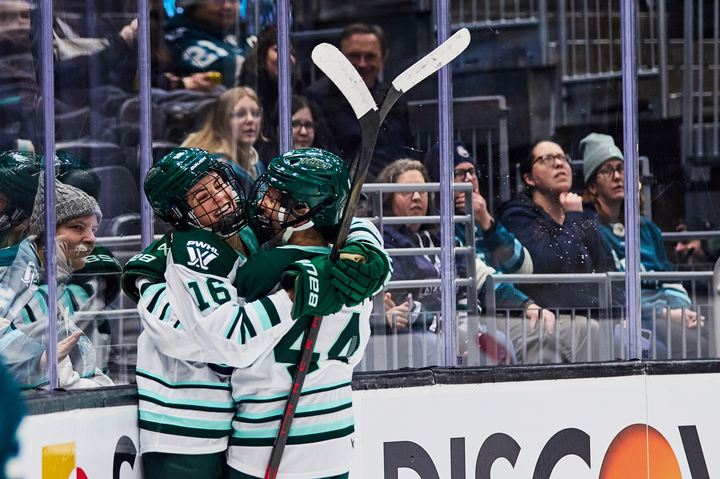Five storylines heading into the 2017-18 NWHL season
From league salaries to the New Jersey Devils partnership and more, there's lots to talk about going into Year Three.
League salaries for Year Three
We’d been kept in the dark about player salaries for the upcoming season up until last week, when The Ice Garden learned players would be making under $10,000 a year (within the $5,000-7,000 range). The highest-paid player this year will be making less than a third of what last year’s highest paid player, the Riveters’ Amanda Kessel, made in a single season ($26,000). Essentially, the pay adds up to the NWHL being a part-time job, putting a new strain on players who already need supplemental jobs to be able to sustain themselves.
The downward trend in pay might be alarming, but it’s not completely unexpected -- not when you take into account that players had to take a 50 percent pay cut last year just to help keep the league afloat. The league’s biggest players responded with a four-point manifesto asking the league to disclose its finances, insurance policies, and revenue streams, as well as the identities of the NWHL’s investors. But now, many of those players are representing their home countries in the upcoming Winter Olympics, and many of the requests they’ve made still aren’t public knowledge.
This is all a part of the process when it comes to establishing any kind of business -- you’re going to have setbacks and struggles. But with the CWHL now promising to pay its players anywhere from $2,000-10,000 Canadian (which means the highest paid players there will be making slightly more in USD than the highest paid in the NW), the NWHL is likely to have some competition moving forward. Plus, there are still a lot of questions surrounding viability and transparency that have yet to be answered.
Metro Riveters and the NHL -- the start of something bigger?
Which brings us to the re-branding and strategic partnership between the Riveters and the New Jersey Devils. The New York Times reported the deal on Oct. 4, detailing the change in branding and color scheme for the Riveters and how the Devils will be assisting with cross-promotion, marketing, and sales, plus development of girls’ hockey initiatives and programs throughout the area. The Riveters’ season opener is also a doubleheader with the Devils at the Prudential Center, and the Riveters will be using the Barnabas Health Hockey House next door rent-free for all of its home games.
League commissioner Dani Rylan and CFO Steve Skillen view this as an opportunity for growth and heightened player visibility, both important to a league like the NWHL, and it’s clear they’re banking on this to help boost its image and its sustainability.
We’ve seen partnerships between NHL and CWHL teams before, but overall much of the NHL’s support for women’s hockey has been verbal. The NWHL has a completely different business model than the CWHL, which could change the game a bit in terms of collaborations like these -- as long as the NHL holds true to its end of the bargain. If this works out, it could mean the start (for better or worse) of more partnerships to come. After all, each of the NWHL’s teams is in the same city as or close to an NHL team…
Out of market games and the potential for expansion growing stronger
It seems like it’s been forever since that graphic at the end of the inaugural Isobel Cup livestream hinting strongly at the potential for the NWHL’s expansion to Canada. Since then, the league seems to be looking within its own borders. It returns to Pittsburgh for a game between the Whale and the Beauts in January, and the Beauts actually open their “home” season with a game in Rochester against the Riveters on Nov. 4.
It certainly looks like the league is testing out potential locations for expansion teams down the line. Pittsburgh is an especially seductive location because of its designation as a major city, its proximity especially to Buffalo (therefore the chance to develop a rivalry) and the potential for a partnership with the Penguins much in the vein of the Riveters-Devils alliance. Plus, it can provide a gateway to Midwestern expansion in the future. The Sporting News article (by TIG’s own Mike Murphy) also mentions the idea of Washington, D.C. as an expansion location, with rumors of it being a possible location for this season’s All-Star Game. Though Rochester is a mid-size city that’s also geographically solid, there’s not as much of a lure if you consider it from a “partner with the NHL” perspective.
Still, keep your eye on the results of each of these games -- the kind of crowds these games attract, how fans respond, and how the league talks about them. This could signal the start of something much bigger -- and don’t forget the effect the CWHL’s expansion to China this year could have on the NWHL’s decision to act.
No Boston-Buffalo three-peat this year…?
As mentioned earlier, we’re in an Olympic year. All the big names you’ve come to associate with the NWHL have centralized, meaning teams have been depleted -- one team in particular being the Boston Pride. The Pride dominated the league last season, going nearly undefeated in the regular season and making it back to the Isobel Cup where they lost narrowly, 3-2, to the Buffalo Beauts.
But the Pride are heading into Year Three with a different-looking roster this time around, missing many of its National Team players as well as crucial players like Blake Bolden (who’s playing in Lugano, Switzerland this season) and Rachel Llanes (who’s back in the CWHL with the Kunlun Red Stars). They’ve managed to fill some of the gaps, hanging onto players like D Alyssa Gagliardi, forwards Emily Field and Jillian Dempsey, and goalie Brittany Ott. They’ve also lured Haley Skarupa, Paige Harrington and Janine Weber away from each of the other three NWHL teams.
With all that said, it’s not just going to be their league anymore -- and it’ll be a lot of fun to see just who will stand out from the rest of the pack this year. Seasons like this are interesting because you get to see players emerging who may have been overlooked otherwise, and it becomes a lot more competitive quickly. With that also, however, comes the challenge of finding someone new to market as the face (or faces) of the league, which can be an obstacle the NWHL doesn’t need. Teams are going to have to come out strong and get creative in order to get new fans interested in the league, because there’s no longer the draw of National Team players to do that for them. Still, that’s no reason to stop watching -- after all, this could be the year we see the Connecticut Whale or Metropolitan Riveters hoist that Cup! Who knows?
Harrison Browne’s return to the ice
What does it mean for the potential for future trans players and perhaps evolution of the trans athlete policy the NW put forth last season?
When Harrison Browne, the first trans athlete in a North American professional team sport, announced his retirement at the end of last season, it was certainly bittersweet. Browne had just won his first (and presumably only) Isobel Cup with the Beauts, and was looking to move on, complete his transition, and move to an advisory position within the NWHL.
But then, in a surprising move, Browne came out of retirement, announcing that he had more to accomplish as a player and was willing to delay his transition in order to do it. He signed with the Metropolitan Riveters and pledged to devote much of his time this season to outreach and volunteering with LGBTQ organizations. (Recently, he spoke at the Trans Wellness Conference in Buffalo, hosted by the Pride Center of WNY.)
A move like this matters, because it continues to set the stage for future trans athletes to attempt playing -- albeit at a price. The inclusion of a trans athlete policy at all within a professional league is huge, but it doesn’t come without its pitfalls. (I’m cisgender, so I’ll refer you to two own-voices perspectives -- Katelyn Burns’ interview with Browne for TIG on his decision, and an analysis by Andrew of the Victory Press of the ways in which the policy limits trans athletes, especially trans women and femmes.) As the NWHL continues to partner itself with the NHL, it becomes a question as well of how policies like this are viewed and either embraced or ignored by a professional men’s league. It’s a lot to chew on, and as the league continues to grow, so should its ideas of inclusion.





Comments ()